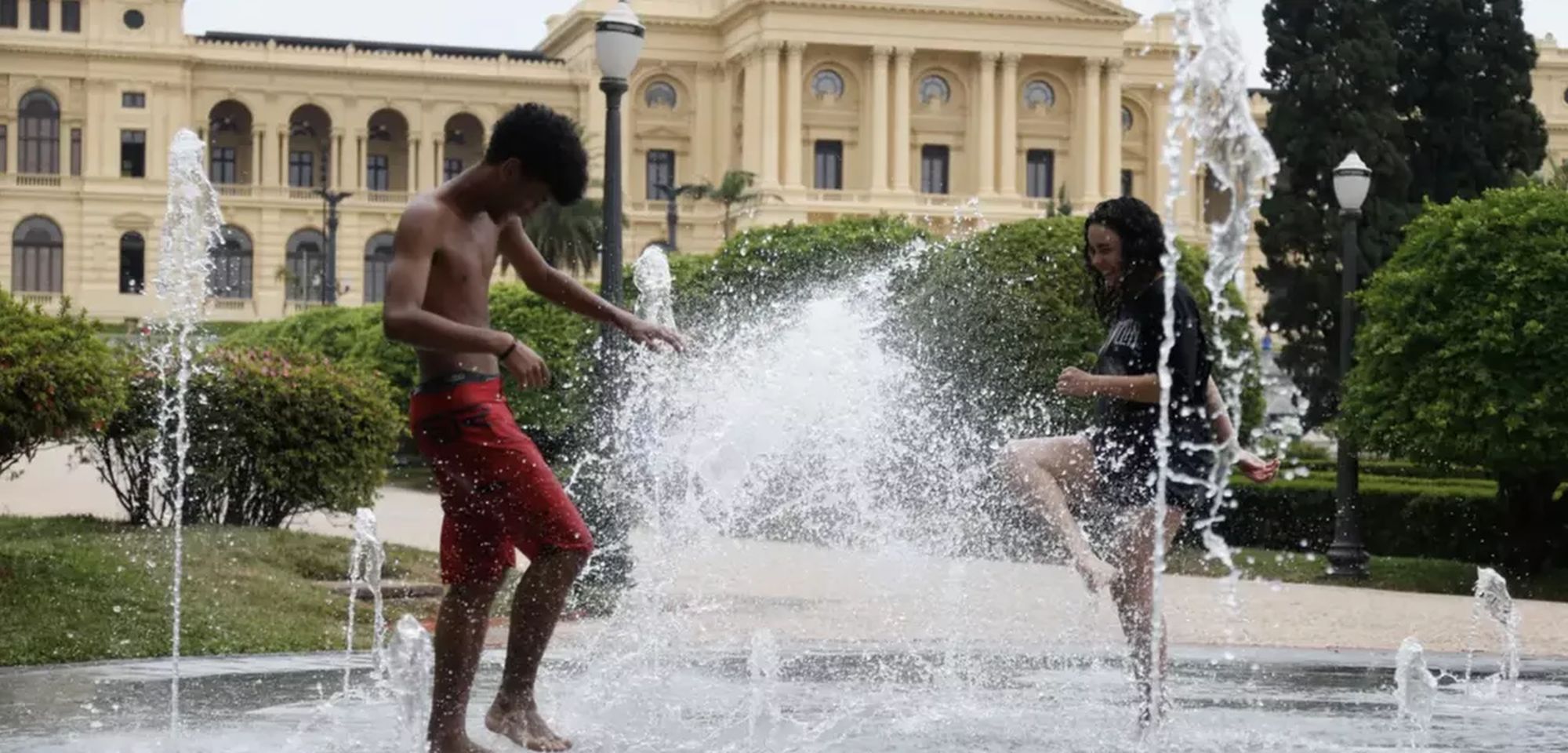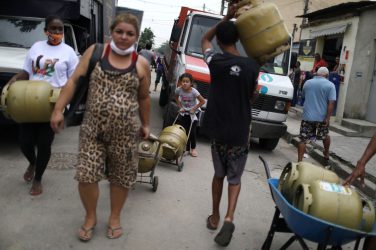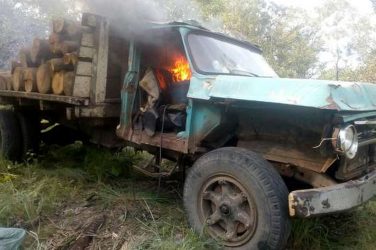“The heat at night was too much; we couldn’t sleep,” says Evanice Auxiliadora da Silva, a resident of Cuiabá, the capital of the state of Mato Grosso in west-central Brazil, as she recalls the numerous heat waves the city experienced last year — which was also the planet’s hottest year on record.
In 2023, a surge of extreme weather events were recorded, including heat waves, whose impacts range from temporary lifestyle changes to adverse health consequences, even death. Worldwide, scientists are scrambling to study these extreme events and their danger to human beings, as the world continues to warm due to human-caused climate change.
Auxiliadora da Silva’s city comprises a set of Brazilian metropolitan regions whose experience with heat waves has been analyzed in a newly published study in the journal PLOS ONE. The paper helps fill a gap in South America, a continent that scientists say still lacks research on the impact of temperature extremes on health.
The study estimates that the deaths of nearly 50,000 people in the continent’s largest country over nearly two decades can be attributed to the occurrence of heat waves. And the paper points out that these extreme events have become increasingly frequent, intense and prolonged.
The study quantifies the impact of heat waves in Brazil and analyzes how socioeconomic factors influence the risk of heat-related illnesses. The researchers further suggest that the impacts of extreme heat, which affects the lives of thousands of people annually, are felt unevenly, thus exposing socioeconomic inequalities.
Auxiliadora da Silva’s experience is an important one. As a 65-year-old Black woman, according to the research, her age and her race place her at greater risk of suffering health effects from heat waves — including death. The researchers found important gender, race and socioeconomic disparities in heat-related mortality. In Cuiabá, a woman such as Auxiliadora da Silva has triple the risk of dying in a heat wave compared with whites, according to the research.
“When a study like this brings scientific evidence that the most impoverished population will suffer the greatest impacts in this process, it is not presenting something random. It is delving into the impacts of land warming on people’s living conditions,” geographer Diosmar Marcelino de Santana Filho, a doctoral student in geography at Federal Fluminense University and senior researcher at Iyaleta Research Association, who was not involved in the study, tells.
‘Heat kills’ — and not always equally
A heat wave is characterized as a prolonged period of exceptionally high temperatures, and Brazil experienced such an event nine times in 2023, which was also the hottest year in the country’s historical series.
The PLOS ONE study, the result of a partnership between Federal University of Rio de Janeiro (UFRJ), University of Brasília, Oswaldo Cruz Foundation (known as Fiocruz) and University of Lisbon, involved a team of 12 scientists who analyzed the evolution of heat waves in the most populous urban areas of Brazil.
The study observed a significant increase in the frequency of heat waves from the 1970s, when Brazil experienced the extreme event from 0-3 times a year, to the 2010s, when the observed figure ranged from 3-11 times.
“Our work showed that heat waves are becoming increasingly frequent in all regions of the country, with more pronounced trends in areas close to the equator,” says Djacinto Monteiro dos Santos, the study’s lead author who is a postdoctoral student at the UFRJ’s Laboratory for Environmental Satellite Applications (LASA by its Portuguese acronym).
The researchers say their findings suggest that although the frequency of heat waves is increasing across the country, the impacts of this exposure are not felt equally across the population.
By integrating socioeconomic variables such as gender, age, race and educational level into its analysis heat waves and their impact on human health, the paper reveals a simple but clear finding:
In the study areas, Blacks, Browns, older adults, women and those of low educational backgrounds are more likely to die in a heat wave, as higher rates of heat-related deaths was observed among these subgroups.
The study says this highlights “how anthropogenic-induced climate change has already exacerbated socioeconomic inequalities in Brazil.”
According to Monteiro dos Santos, this result shows that social and gender inequalities and structural racism in Brazil multiply the impacts of climate change.
“The population living on the outskirts of cities, in regions with precarious housing conditions, lack of basic sanitation, little supply of green areas, difficulties in accessing health services, energy insecurity and limited resources for adapting to heat are the most vulnerable.”
In total, data from 14 metropolitan regions from all corners of the country, which together comprise 74 million people representing nearly one-third of Brazil’s population, were analyzed.
The study’s lead author says that in addition to being more frequent, heat waves have become longer and more intense, showing that the majority of the Brazilian population is becoming increasingly exposed to prolonged periods of high temperatures, “which represents a serious threat to human health.”
The study’s approach enabled the researchers to estimate that between 2000 and 2018, the deaths of 48,075 people could be attributed to the growing number of heat waves, mainly due to respiratory and cardiovascular diseases.
That figure is 20 times greater than the number of deaths associated with landslides nationwide for the same period. Yet, “extreme heat is still a neglected disaster in Brazil,” the authors write. “Heat kills, and our study was able to quantify this impact,” the lead researcher adds.
Progress toward ‘climate adaptation’
Headquartered in Salvador, the capital of the state of Bahia in northeast Brazil, the Iyaleta Research Association is an observer in the United Nations Framework Convention on Climate Change (UNFCCC) process. It investigates climate change and racial, gender, social and territorial inequalities, mainly in urban areas of the Amazon and northeast Brazil.
Filho, who also serves on the scientific coordination of the association, says the newly published research is important because it joins others in analyzing the racial and gender dimensions of populations that are the most vulnerable to extreme events. “The study provides a good overview, and we have made progress in discussing climate adaptation.”
He explains that in climate change communication, heat waves are not conveyed in the same way as other extreme events. “If it’s rain that takes everything away, destroys everything, everyone quickly says, ‘It impacted, everything was lost.’ But with heat, it directly impacts people’s health and quality of life. It doesn’t have a material impact — the material image of a flooded car, a submerged house, clothes, sofas on the street.”
The researcher asserts that in this matter, the study is also enriching because it quantifies the impact of extreme events on the country.
However, as a researcher in the field of ethnic and racial relations, Filho says he believes the scenario highlighted by the PLOS ONE study is not new, as others, including the Intergovernmental Panel on Climate Change, have already reported that vulnerable communities that have historically contributed the least to current climate change are disproportionately affected.
“Racial, gender and ethnic factors are determinants in the lives of the population currently facing climate vulnerability. … All of our studies already show that the inequalities are racial,” says Filho. A 2022 study by the Iyaleta Research Association, which Filho co-authored, revealed that, compared with white women (86.3%) and men (85.91%), Black women (79.38%) and men (78.24%) residing in the urban area of Cuiabá — the city where Auxiliadora da Silva lives — have the lowest proportion of access to adequate sewage facilities.
He says that even access to water during heat waves is differentiated, and he points out that when racial and gender determinants are considered, the most impacted are women and Black individuals.
“With territorial warming, you need water supply and sanitation to be able to serve these people in what would be collective public services. If it’s very hot, you drink water,” he says. But in the peripheral areas of large centers and capital cities, “water is sometimes unavailable for up to 20 days.”
The lack of infrastructure issue
Every attempt to adapt to survive extreme events counts, as the climate keeps warming over the long term and heat waves keep becoming not only more frequent, but also longer-lasting and more intense.
Last year, 2023, was confirmed as the warmest calendar year in global temperature data records going back to 1850, marking the first time on record that every day within a year exceeded 1°C (1.8°F) above the 1850-1900 preindustrial levels, according to the Copernicus Climate Change Service.
In Brazil, the average temperature for 2023 was 24.92°C (76.9°F), which is 0.69°C (1.24°F) above the historical average for 1991-2020 (24.23°C or 73.4°F), and nine out of 12 months had monthly temperature averages above this historical average, the country’s National Institute of Meteorology (INMET) reports.
But large cities in Brazil lack the infrastructure to cope with heat waves, says Filho, the senior researcher at Iyaleta Research Association. He explains that in a population already impoverished, without the means and infrastructure to deal with the current climate reality, “the impact is directly on the living conditions of these people.”
Auxiliadora da Silva remembers her journey to cool off during last year’s heat waves. “It was really bad because we don’t have air conditioning. … We had to put a basin with water, wet the towel, and sometimes even wet the bed to be able to sleep. We slept with the window open, hoping for a breeze.”
Filho says these realities demand adaptation to prevent having to endure long cycles of temperature change, whether it’s in people’s homes, on the streets or even at a bus stop.
“I’m referring to the majority of people who rely on collective service infrastructure,” he says, meaning urban structures provided for common use, such as public squares, avenues, hospitals, schools, universities, sports courts and drainage systems.
The researcher explains that otherwise, in the face of extreme events like the ones the planet is experiencing — climate change and phenomena like El Niño — the impact relies on the conditions of those experiencing the deepest inequalities. Such is the reality in Brazil.
“By reducing access to [housing quality] conditions in territories, people are placed in climate vulnerability in urban spaces. Being placed in climate vulnerability in urban spaces, they occupy areas where they are marginalized. By being marginalized, they become direct victims of what we are experiencing in terms of climate change and warming,” he adds.
As an example, the researcher cites what recently occurred in the coastal tourist region of Valparaíso, in central Chile. There, more than 100 people died during wildfires amid a long drought followed by an exceptional heat wave. “These people died due to poverty, lack of infrastructure and prevention measures to avoid being burned,” he says.
The need to address inequality
Along with São Paulo, Cuiabá experienced its hottest winter in 63 years in 2023. While enduring the heat waves of that year, the city was also, on more than one occasion, the hottest capital in Brazil.
Auxiliadora da Silva attributes deforestation as a key factor that exacerbates the heat. She asserts that “creating greener areas” could help those suffering the most during heat waves. “In Cuiabá, they cut down all the trees. … There are no trees … [so we need to] plant more trees,” she says.
According to Monteiro dos Santos, the study’s lead author, the paper notes the urgent need for action to help people adapt during heat waves. This includes “the issuance of early warnings, public awareness and infrastructure to provide shelter for the most vulnerable people, in addition to adaptation from public transportation systems to extreme heat and strengthening [the] Brazilian health system,” the researcher says.
However, just that alone may not suffice. The results show the importance of the debate on environmental racism and social justice in the context of climate change, he says.
“Public adaptation policies need to be linked to policies to reduce regional, social, racial and gender inequalities that still exist in Brazil,” the researcher underscores.
Examining Brazil’s context, Filho, the senior researcher at Iyaleta Research Association, says it’s not possible to talk about climate adaptation without addressing racial inequalities. “In a reality like Brazil’s, the Black population is the one facing unfavorable conditions in education, job access, infrastructure, public policy and sanitation.” Addressing climate adaptation requires not just reducing but “eliminating inequality,” he says. “It’s an impossible task, but it’s what we want to strive for.”
Filho stresses that this applies especially to countries that underwent colonization processes like Brazil — and others as well. “From Canada to Patagonia [in the southern cone of South America], you find Black populations and Indigenous peoples living with racial inequalities, and they are the most impacted by climate change.”
In a 2023 technical note, the Iyaleta Research Association recommended that the revision of Brazil’s federal National Adaptation Plan (NAP) take into account the establishment of goals and funding capable of reducing inequalities in the living conditions of urban and rural populations with regard to the prevention of extreme events. The NAP aims to guide initiatives to manage and reduce long-term climate risks.
Filho, who co-authored the note, states that the benefits to a climate adaptation process that take into account racial and social dimensions are many, including what he calls a major global health project. And this is for a simple reason:
“If I improve housing conditions, access to transportation and sanitation, water supply, jobs where you don’t have to commute, leisure, sports — I create an infrastructure for people’s living conditions, I provide them with health conditions,” he says.
The researcher is emphatic: “To solve global warming, we need to address the warming in the lives of vulnerable people, who are the majority.”
Citations:
Monteiro dos Santos, D., Libonati, R., Garcia, B., Geirinhas, J., Salvi, B., Lima e Silva, E., … Trigo, R. (2024). Twenty-first-century demographic and social inequalities of heat-related deaths in Brazilian urban areas. PLOS ONE. Retrieved from doi:10.1371/journal.pone.0295766
Robinson, P. J. (2001). On the definition of a heat wave. Journal of Applied Meteorology, 40(4), 762-775. doi:10.1175/1520-0450(2001)040<0762:otdoah>2.0.co;2
This article appeared originally in Mongabay. Read the original article here:
https://news.mongabay.com/2024/03/study-on-brazilian-heat-wave-deaths-shows-gender-racial-disparities/












